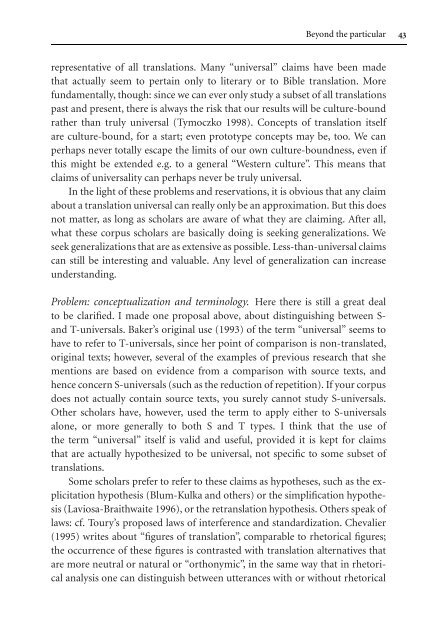Translation Universals.pdf - ymerleksi - home
Translation Universals.pdf - ymerleksi - home
Translation Universals.pdf - ymerleksi - home
Create successful ePaper yourself
Turn your PDF publications into a flip-book with our unique Google optimized e-Paper software.
Beyond the particular 43<br />
representative of all translations. Many “universal” claims have been made<br />
that actually seem to pertain only to literary or to Bible translation. More<br />
fundamentally, though: since we can ever only study a subset of all translations<br />
past and present, there is always the risk that our results will be culture-bound<br />
rather than truly universal (Tymoczko 1998). Concepts of translation itself<br />
are culture-bound, for a start; even prototype concepts may be, too. We can<br />
perhaps never totally escape the limits of our own culture-boundness, even if<br />
this might be extended e.g. to a general “Western culture”. This means that<br />
claims of universality can perhaps never be truly universal.<br />
In the light of these problems and reservations, it is obvious that any claim<br />
about a translation universal can really only be an approximation. But this does<br />
not matter, as long as scholars are aware of what they are claiming. After all,<br />
what these corpus scholars are basically doing is seeking generalizations. We<br />
seek generalizations that are as extensive as possible. Less-than-universal claims<br />
can still be interesting and valuable. Any level of generalization can increase<br />
understanding.<br />
Problem: conceptualization and terminology. Here there is still a great deal<br />
to be clarified. I made one proposal above, about distinguishing between S-<br />
and T-universals. Baker’s original use (1993) of the term “universal” seems to<br />
have to refer to T-universals, since her point of comparison is non-translated,<br />
original texts; however, several of the examples of previous research that she<br />
mentions are based on evidence from a comparison with source texts, and<br />
hence concern S-universals (such as the reduction of repetition). If your corpus<br />
does not actually contain source texts, you surely cannot study S-universals.<br />
Other scholars have, however, used the term to apply either to S-universals<br />
alone, or more generally to both S and T types. I think that the use of<br />
the term “universal” itself is valid and useful, provided it is kept for claims<br />
that are actually hypothesized to be universal, not specific to some subset of<br />
translations.<br />
Some scholars prefer to refer to these claims as hypotheses, such as the explicitation<br />
hypothesis (Blum-Kulka and others) or the simplification hypothesis<br />
(Laviosa-Braithwaite 1996), or the retranslation hypothesis. Others speak of<br />
laws: cf. Toury’s proposed laws of interference and standardization. Chevalier<br />
(1995) writes about “figures of translation”, comparable to rhetorical figures;<br />
the occurrence of these figures is contrasted with translation alternatives that<br />
are more neutral or natural or “orthonymic”, in the same way that in rhetorical<br />
analysis one can distinguish between utterances with or without rhetorical
















